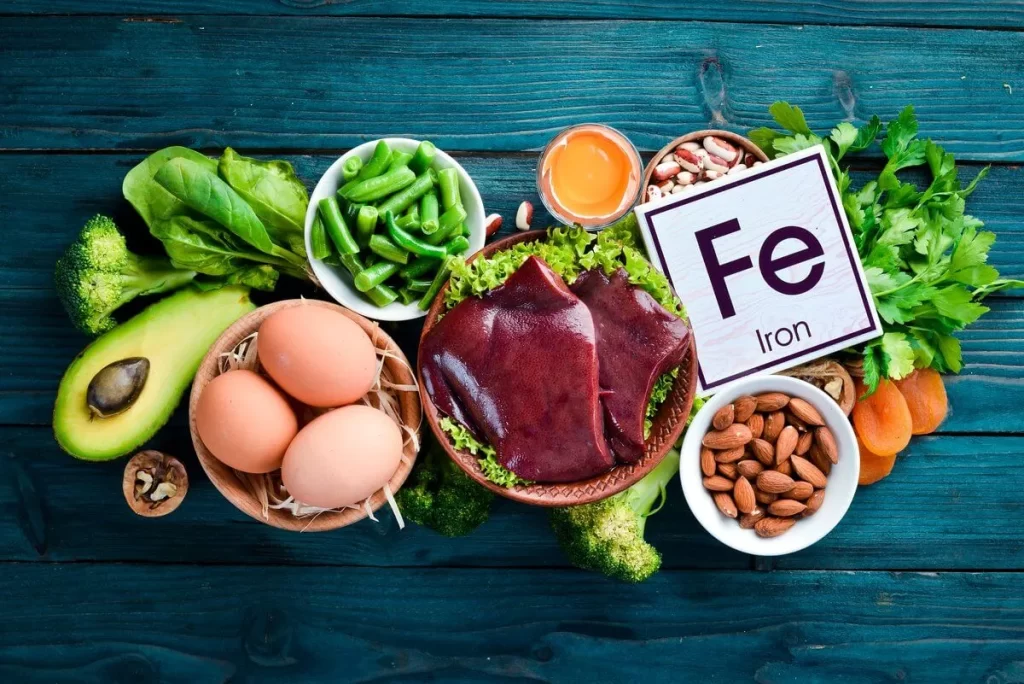Introduction
Iron deficiency is a worldwide health problem that affects reproductive function, cognitive development, and work capacity. What Decreases Iron Absorption? Which foods could decrease iron absorption? This article will discuss several factors that could decrease iron absorption in your body.
Iron and Human Health
Iron is involved in multiple metabolic processes, including oxygen transport, DNA synthesis, and electron transport.
Food contains two types of iron: heme iron and non-heme iron. Meat, fish, and poultry contain heme iron. Non-heme iron can be found in both vegetable and animal products.
When consumed in large quantities, it is also toxic. As a result, its effect on the body is a double-edged sword.
Iron deficiency does not always cause anemia, but it can lead to other health issues like lethargy and a weakened immune system. It is caused by a lack of iron-rich foods in the diet, blood loss, or an increased need for iron during adolescence i.e., due to heavy menstrual bleeding and during pregnancy.
What Decreases Iron Absorption?
There is a variety of dietary factors that can affect iron absorption. It could be a combination of inhibitory and enhancing factors. In this article, only inhibitors will be discussed.
Phytate –This compound is found in plant-based diets and has a dose-dependent effect on iron absorption.
Polyphenols – They are found in black and herbal tea, coffee, wine, legumes, cereals, fruit, and vegetables.
Calcium – It inhibits both heme and non-heme iron, unlike other inhibitors which act on non-heme iron absorption only.
Animal proteins – Animal proteins such as egg whites, whey, casein, and proteins from plants (soy protein) can inhibit iron absorption in humans.
Oxalic acid – It can be found in chard, spinach, beans, and nuts and acts to bind and inhibit iron absorption.
Normally, dietary sources alone are unlikely to be sufficient to cause any harm.
1. Calcium
Calcium is an essential mineral; the human body can get this element from the diet.
Calcium can be found in milk, cheese, yogurt, canned salmon, sardines, tofu, almonds, figs, rhubarb, broccoli, and turnip greens.
Unlike other inhibitors, calcium can inhibit the absorption of both heme and non-heme iron.
When the calcium content of a meal exceeds 50 mg, non-heme iron is inhibited and the inhibition is maximal at about 300 mg.
Studies assume that ≥ 100 mg calcium inhibits both heme and non-heme iron absorption by 50%.
2. Animal Proteins
Milk proteins, egg proteins, and albumin have all been found to inhibit iron absorption.
The two major bovine milk protein fractions, casein, and whey, as well as egg white, have been shown to inhibit iron absorption in humans.
Soybean proteins also reduce iron absorption.
Eggs
Eggs, which are frequently recommended because of their high iron content, actually contain a compound that prevents iron absorption (phosphoprotein).
Phosphoprotein, also known as phosvitin, is an iron-binding protein that may contribute to eggs’ low iron bioavailability. The “egg factor” refers to this iron-inhibiting property of eggs.
3. Polyphenols
Polyphenols or phenolic compounds (tannins) include chlorogenic acid found in tea, coffee, cocoa, red wine, many vegetables (spinach), grains (red sorghum), herbs, and spices (oregano, cinnamon) contain such phenolic compounds.
They all have an inhibitory effect on iron absorption.
4. Coffee
Coffee contains a high concentration of tannin and chlorogenic acid; one cup of certain types of coffee can inhibit iron absorption by up to 60%.
These foods or substances should be avoided two hours before and after your main iron-rich meal.
5. Phytate
Phytates are a storage form of phosphates and minerals in soy protein, fiber, cereals, seeds, nuts, vegetables, and fruit.
Phytates inhibit iron absorption in a dose-dependent manner, and even small amounts of phytate have a significant impact.
Ascorbic acid, meat, fish, and poultry can all help to counteract the effects of phytate.
Related: Association Between Iron Deficiency Anemia and Anxiety
6. Tea
Tea flavonoids are thought to be responsible for tea’s inhibitory effect on non-heme iron absorption.
Tea flavonoids are polyphenols with two aromatic rings as functional groups and two or more hydroxyl groups.
The tea inhibits iron absorption by forming a complex of tea flavonoids with iron, primarily the galloyl group in these phenolic compounds, which binds iron specifically.
7. Zinc
Zinc is an essential mineral found in seafood, eggs, meat, and to some degree in grains.
Supplemental zinc in high doses can interfere with copper utilization, resulting in iron metabolism problems.
Supplemental zinc in doses of 20 milligrams or less can be taken between meals without affecting iron absorption.
8. Iron Competitors
Several other heavy metals may share the iron intestinal absorption pathway.
These include lead, manganese, cobalt, and zinc (as discussed before).
Because iron deficiency frequently occurs alongside lead poisoning, this interaction can result in particularly serious medical complications in children.
Lead is especially harmful to iron metabolism.
Lead is taken up by the iron absorption machinery (DTM1) and then blocks iron via competitive inhibition. Furthermore, lead disrupts many critical iron-dependent metabolic steps, such as heme biosynthesis.
Read Also: Iron Deficiency Anemia Causes, Symptoms and Treatments
Summary
Iron is a vital element in the body. It plays an important role in a variety of metabolic processes, including oxygen transport, deoxyribonucleic acid (DNA) synthesis, and electron transport.
When consumed in large quantities, it is also toxic. As a result, its effect on the body is a double-edged sword. Iron deficiency does not always cause anemia, but it can lead to other health issues like lethargy and a weakened immune system.
Iron deficiency is caused by a lack of iron-rich foods in the diet, blood loss, or an increased need for iron during adolescence and pregnancy.
There is a variety of dietary factors that can affect iron absorption. It could be a combination of inhibitory and enhancing factors. In this article, only inhibitors will be discussed.
What Decreases Iron Absorption – Factors that could decrease iron absorption include calcium, some animal proteins, polyphenols, coffee, phytate, tea, oxalic acid, and iron competitors such as lead, manganese, cobalt, and zinc.
These foods or substances should be avoided two hours before and after your main iron-rich meal and seek medical advice if you suspect that you have iron deficiency symptoms.
[ratemypost]
References
- Abbaspour, N., Hurrell, R., & Kelishadi, R. (2014, February). Review on iron and its importance for human health. Journal of research in medical sciences : the official journal of Isfahan University of Medical Sciences. Retrieved September 22, 2021, from PubMed.
- Dasa, F., & Abera, T. (2018, December 24). Factors affecting iron absorption and mitigation mechanisms: A review. International Journal of Agricultural Science and Food Technology. Retrieved September 22, 2021, from Peertechz Publications.
- Effect of tea and other dietary factors on iron absorption. Taylor & Francis. Retrieved September 22, 2021, from PubMed.
- Ems, T. (2021, April 26). Biochemistry, iron absorption. StatPearls [Internet]. Retrieved September 22, 2021, from PubMed.
- Garrison, C. D., Weinberg, E. D., & Skikne, B. (2009). The iron Disorders Institute guide to anemia. Cumberland House.
- JR;, H. Dietary and physiological factors that affect the absorption and bioavailability of Iron. International journal for vitamin and nutrition research. Internationale Zeitschrift fur Vitamin- und Ernahrungsforschung. Journal international de vitaminologie et de nutrition. Retrieved September 25, 2021, from PubMed.

